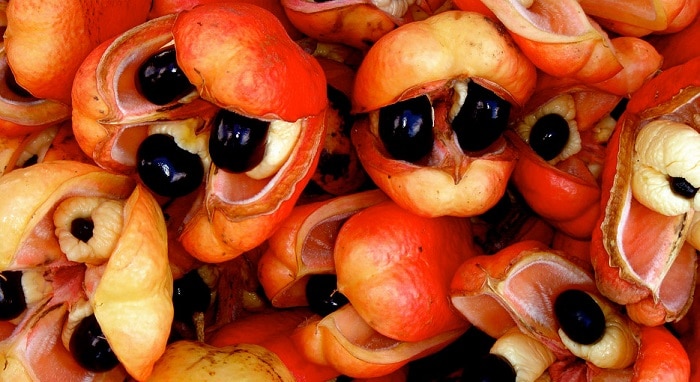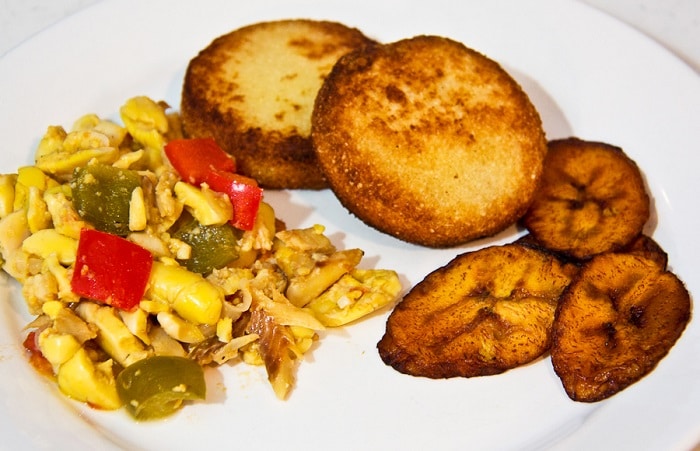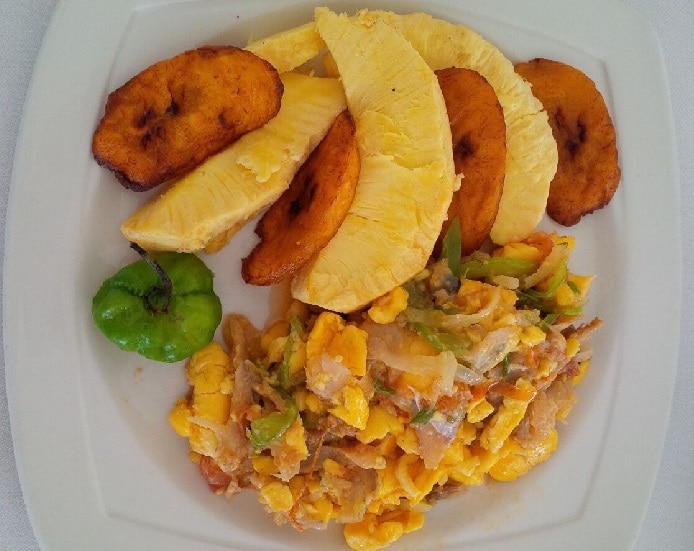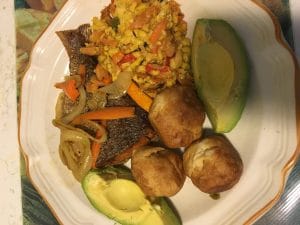Ackee and saltfish is a beloved Jamaican dish anyone should try at least once in their life. In fact, it’s the national dish of the Caribbean country, and the people there eat it any time of the day. Ackee is also the national fruit of Jamaica. However, some Jamaicans consider ackee a vegetable.
The dish consists of sautéed salt fish with boiled ackee, tomatoes, onions, thyme, garlic, black pepper, as well as optional ingredients. Jamaicans often serve it with dumplings, boiled yellow ham, breadfruit, boiled bananas, or fried plantain. Let’s find out more about this delicious dish and allow us to share an ackee and saltfish recipe that you will surely love.
The History of Ackee and Saltfish
Ackee, also known as ackee apple, is actually a pear-shaped fruit. It’s a member of the Sapindaceae, which makes it similar to the lychee and the longan. We find it in warm climates, being native to tropical West Africa. Ackee was imported to Jamaica from Africa before 1778, and it soon became a major ingredient in various Caribbean dishes. Curiously, although an African fruit, Jamaicans use and love it the most.
When the fruit ripens, it turns bright red, then takes a yellow-orange color at its ripest stage. It is then that it splits open, revealing large black seeds that are surrounded by a soft flesh known as aril. Prior to cooking, the arils are boiled for a few minutes. The leaves, bark, seeds and fruit can be used medicinally.
Ackee is packed with nutrients, vitamins, and minerals. It contains omega 6 oil, fatty acids, vitamin A and vitamin C, potassium, phosphorous, zinc, calcium, protein, and fiber. It can help with a number of health problems, including diabetes, digestive issues, elevated blood pressure, high cholesterol levels, anemia, and more.
Canned ackee is one of the leading export products in Jamaica. As a matter of fact, the ackee industry in this island nation was valued at $400 million back in 2005. The U.S. market too receives its ackee from Jamaica and other Caribbean countries such as Haiti. Yet there have been restrictions at times due to the unripe ackee being imported into the States.
Unripe ackee contains the toxins hypoglycin A and hypoglycin B. This leads to a condition called Jamaican vomiting sickness. The illness starts a few hours after eating the unripe fruit or its inedible parts. Symptoms include vomiting and seizures, and the toxicity may even result in death. Given that the treat is very real, do wait until the fruit has ripened and opened up.

The consumption of saltfish in Jamaica started hundreds of years ago. Slave owners view it as a cheap but protein-rich food for the people working on the plantation. They would purchase the low-grade codfish in exchange for rum and molasses. Over the years, the status of cheap fish has changed. It is now a main food ingredient to many dishes.
The majority of salt fish sold in Jamaica is saithe and hake that are caught in the North Atlantic Ocean. To ensure preservation, the fisherman salt and dry it. Its resilience and long shelf life have obviously helped increase its popularity.
Ackee and Saltfish Recipe
Ingredients
- 2 dozen ackees.
- Half a pound of salted codfish.
- One ripe plantain.
- One medium tomato, chopped.
- ¼ cup coconut oil.
- One chopped red sweet pepper.
- One chopped green sweet pepper.
- A pack of Bammy.
- One cup milk.
- A few pimento seeds.
- One chopped onion.
- Salt and pepper.
- One tablespoon sugar.
- 2 tablespoons vegetable oil.
- One tablespoon butter.
- Oil for frying.
Soak the salt fish overnight, and in the morning pour it off and add fresh water. Bring to a boil and taste the fish to make sure that most of the salt has gone out of it. If it is still too salty, then pour off the water and add fresh one, boiling the fish once more. However, don’t allow it to turn completely bland. Take the fish out of the water and let it cool. Then break it into small pieces and remove the bones.
Now let’s move on the ackee. If you’re using fresh fruit, boil it in salted water for 15 minutes or until you can easily stick the fork in them. Careful not to overcook the ackees. Drain and set them aside.
When using canned ackees, you still have to boil the fruit. Drain the liquid from the can and add the fruit to a pot of boiling water. Leave the ackees in there for 2 to 3 minutes. Take them out and let’s move on to the vegetables.
In a large skillet, warm the coconut oil over medium heat. Add the tomatoes, onions, and peppers. Sauté for about 5 minutes, or until they soften. Add the saltfish and stir well. Then, add the ackee and season with salt and pepper. Stir gently as the ackee can break. Now cover the skillet and let the dish simmer for about 15 minutes.
Moving on to the bammies, take a shallow dish and dissolve the sugar in the milk. Place the bammies in there and leave them to soak up the milk for about 5 minutes. Flip them onto the other side to absorb the sweetened milk.
Now take out the skillet once more and place it over medium heat. Fry the soaked bammies in oil and butter until they turn golden brown. Generally, each side should be done in about 8 minutes. Take them out on a paper towel.
Finally, slice the plantain diagonally and fry each piece until golden brown. Place them on a paper towel to soak up the oil.

While you can eat this dish anytime you want, Jamaicans traditionally serve it as a breakfast meal on weekends, or on special occasions. We can’t emphasize the importance of choosing the fruit correctly. Ackee is not as harmless as it looks. Of course, you can always take a trip to Jamaica and serve this tasty dish right where it has first seen the light of day. Since ackee and saltfish is a national dish, you can find it in any local restaurant. Share with us your cooking or travel experiences.


